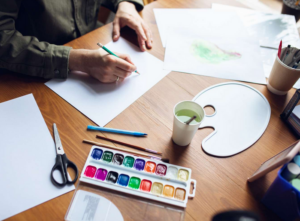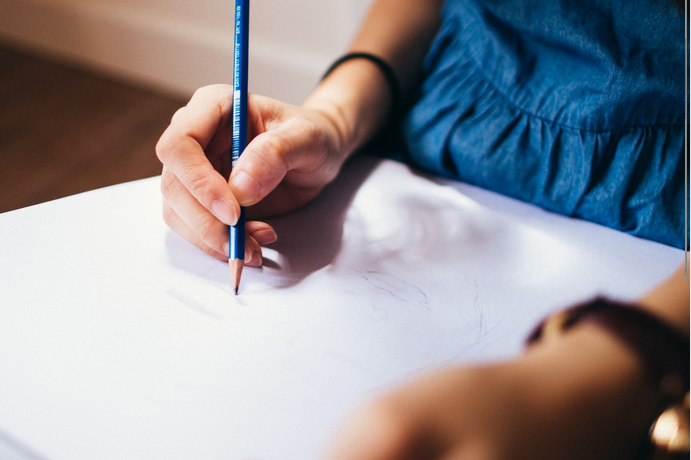In today’s fast-paced world, stress has become an all too common companion, affecting our physical, mental, and emotional well-being. While there are many strategies for managing stress, one often overlooked method is finger drawing therapy. This simple yet powerful technique harnesses the creative process to reduce stress and promote relaxation, offering a therapeutic outlet for individuals seeking relief from the pressures of daily life. In this enlightening guide, we’ll explore the art of finger drawing and how it can help you find inner peace and tranquillity.

Understanding Finger Drawing Therapy
Finger drawing therapy, also known as finger painting or finger sketching, is a form of art therapy that involves using your fingers as the primary tool for creating artwork. Unlike traditional drawing methods that rely on pens, pencils, or brushes, finger drawing allows individuals to directly manipulate paint or other drawing materials with their fingertips, fostering a tactile and sensory experience.
The Therapeutic Benefits of Finger Drawing
Mindfulness and Presence
Engaging in finger drawing requires focused attention and concentration, allowing individuals to immerse themselves fully in the present moment. This mindfulness practice promotes relaxation by shifting the focus away from stressful thoughts and worries and grounding the individual in the here and now.
Stress Reduction
The rhythmic and repetitive motion of finger drawing has a calming effect on the nervous system, helping to reduce levels of stress hormones such as cortisol and adrenaline. As individuals become absorbed in the creative process, they experience a sense of flow and relaxation, leading to feelings of tranquillity and inner peace.
Emotional Expression
Finger drawing provides a nonverbal outlet for expressing and processing emotions, making it particularly effective for individuals who struggle to articulate their feelings verbally. Through the act of creating art, individuals can externalize their emotions, release pent-up tension, and gain insight into their inner world.
Creative Self-Expression
Finger drawing encourages spontaneity, experimentation, and self-expression, allowing individuals to tap into their creative instincts and explore their innermost thoughts and feelings. This freedom of expression fosters a sense of empowerment and self-discovery, boosting self-esteem and confidence.
Sensory Stimulation
The tactile sensation of finger drawing stimulates the sense of touch, providing a rich sensory experience that can be both comforting and soothing. Running fingertips across different textures and surfaces engages the brain’s sensory pathways, promoting relaxation and sensory integration.
How to Practice Finger Drawing Therapy
Create a Relaxing Environment
Find a quiet and comfortable space where you can engage in finger drawing without distractions. Set the mood with soft lighting, calming music, and aromatherapy scents to enhance the relaxation experience.
Gather Your Materials
Choose drawing materials that appeal to you, such as paint, pastels, or coloured pencils, along with paper or canvas. Experiment with different textures and colours to find what resonates with you.
Set an Intention
Before you begin drawing, take a moment to set an intention for your practice. This could be to release stress, cultivate inner peace, or simply enjoy the process of creating art.
Let Go of Expectations
Approach finger drawing with an open mind and a spirit of curiosity. Let go of any judgments or expectations about the outcome and allow yourself to explore and play with the materials freely.
Engage Your Senses
Pay attention to the sensations of drawing with your fingers—the texture of the paper, the smoothness of the paint, and the temperature of the colours. Allow yourself to fully immerse in the sensory experience.
Express Yourself
Use finger drawing as a means of self-expression, allowing your emotions and intuition to guide your artistic process. Trust your instincts and let your creativity flow without inhibition.
Reflect and Relax
After you’ve finished drawing, take a moment to reflect on your experience. Notice how you feel physically, mentally, and emotionally. Allow yourself to bask in the sense of relaxation and well-being that finger drawing has brought you.
Conclusion
In conclusion, finger drawing therapy offers a simple yet profound way to reduce stress, promote relaxation, and cultivate inner peace. By engaging in this creative practice, individuals can tap into their innate creativity, express their emotions, and find solace amidst life’s challenges. Whether you’re a seasoned artist or a novice doodler, finger drawing provides a therapeutic outlet for anyone seeking relief from the pressures of modern living. So grab some paper, unleash your creativity, and discover the healing power of finger drawing for yourself.

